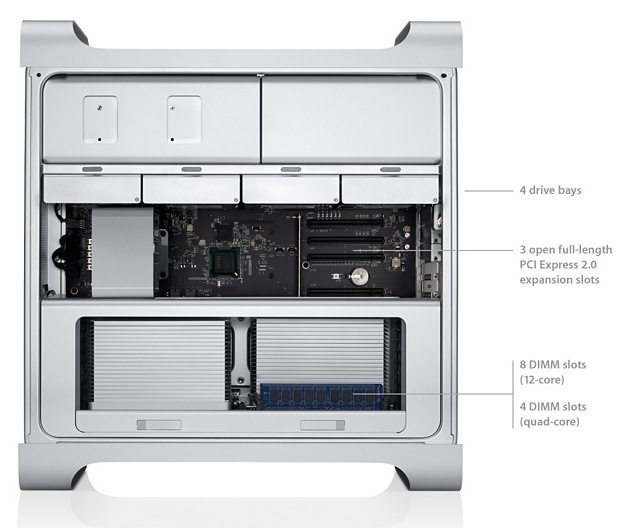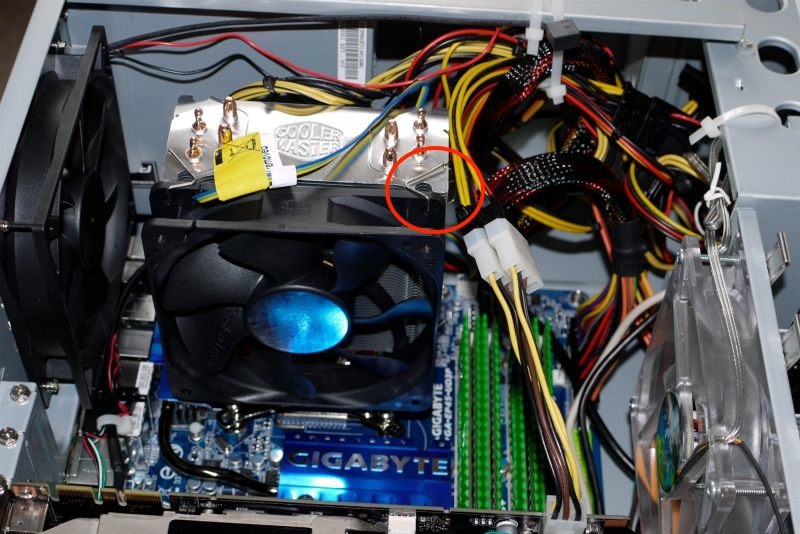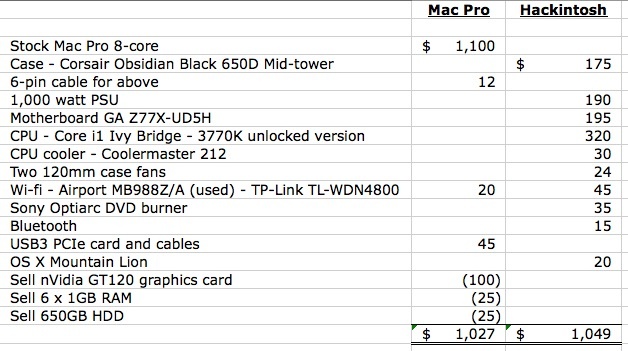The value proposition.
For an index of all my Mac Pro articles, click here.

The Mac Pro’s interior – engineering elegance redefined.

The interior of the Hackintosh –
made by the same people who assembled Fiats in the 1960s.
Here I take a quick look at the differences in the cost of acquisition between an used 8-core 2009 Mac Pro and a new Core i7 Ivy Bridge Hackintosh.
I am focusing on differences only. Displays, memory, SSDs, hard drives, GPUs, keyboards, mice, cables and so on are identical for like-equipped machines and can cost as much or as little as you desire.
The comparison commences with an 8-core 2 x 2.26GHz Intel Xeon 2009 Mac Pro, at the price I paid. The only additions to the chassis to make things comparable are a used Airport card, with the GT120 stock GPU being sold. Both machines can use a GPU of choice – it’s not a component of difference.
The stock twin Intel Xeon CPUs in the Mac Pro deliver performance identical to an Ivy Bridge i7. They can be readily upgraded for less than $500 for a 50% boost in performance – the Xeon is not easily overclocked. The Ivy Bridge is pretty much maxed out stock, though the unlocked version can be overclocked for maybe a 25% performance gain. At that point the Mac Pro will be the faster machine, and will be considerably superior on multi-threaded operations.
The Mac Pro is stripped of dated components including its memory, hard drive and the GT120 graphics card, the latter still in production and commanding a good used price. That GPU is a dated slowcoach, not up to modern demands.
Now you can see why a Hackintosh no longer makes economic sense. The Hack’s Corsair Obsidian is a nice case, but at 25lbs of pressed steel to 41 lbs of machined alloy it cannot hold a candle for quality, robustness or modularity to the Mac Pro. For that matter, nothing can. The Mac Pro has to add USB3, built-in on the Hack’s Gigabyte motherboard, whereas everything in the Hack – PSU, motherboard, CPU, cooler, fans and so on, is extra.

Elements of difference – Mac Pro vs. Hackintosh.
The cost is near-identical between the two machines but the Mac Pro owner, in addition to pride of ownership, never has to tinker, hack or worry about OS upgrades. He will never know the misery of ‘Boot0’ errors or arcane fixes to get online to the AppStore. He will also enjoy a resale value exceeding 80% of cost whereas the Hack owner will lose 50% over the next 3 years. While a well engineered Hackintosh can be reliability personified – mine was – any major OS change involves much research, reading and delay before implementation, for fear of breaking something. The Mac Pro user, by contrast, simple clicks on the ‘Upgrade’ box. What’s your time worth?
The Mac Pro buyer’s biggest issue is finding a nice, clean 8-core machine – a task made no easier by my series of articles on the value offered! After that, he’s ahead of the game economically, psychically and operationally.